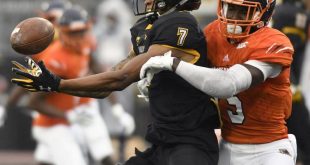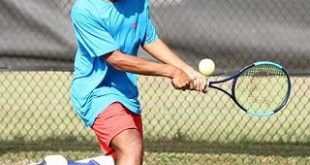CONTACT:
Floyd Kerr, 443-885-3050
This past May 20, Morgan State University President David Wilson began acting on recommendations from the university’s Return to Greatness Steering Committee. The group, commissioned by President Wilson in June 2013, had been charged with conducting a strategic assessment of Morgan’s football program, identifying best practices for operating a Division I Football Championship Subdivision (FCS) program, and making recommendations to help Morgan football reclaim its winning legacy.
From 1935 to 1980, Morgan State’s football program attained the status of legend. During that time, the Bears won a total of 23 conference championships: 19 in the Central Intercollegiate Athletic Association (CIAA) and four in the Mid-Eastern Athletic Conference (MEAC). In addition, they were one-time NCAA Mid-Atlantic College champions, three-time Orange Blossom Classic champions and a one-time winner of the Tangerine Bowl (now the Capital One Bowl). During those same years, Morgan produced 18 All-Americans and scores of players who went on to success in the National Football League, among them, four NFL Hall of Famers: Willie Lanier, Len Ford, Roosevelt Brown and Leroy Kelly.
“Ask prominent Morgan graduates from the 1940s, ’50s or ’60s why they chose to attend their alma mater, and an answer you’ll often get is that they were attracted by the success of the football team,” says MSU Athletic Director Floyd Kerr. “This trend is not uncommon for colleges and universities in the U.S.”
In fact, statistics confirm the link between the success of athletic programs at institutions of higher education and the quantity and academic quality of their student applicants.
“Winning athletic programs boost enrollment,” said Kevin M. Banks, Ed.D., Morgan’s vice president for Student Affairs and co-chairman of the steering committee. “We know there’s a correlation…. You look at any major team that wins a championship or gets close to one: it boosts applications.”
Knowing these facts, Dr. Wilson took steps toward a “Return to Greatness,” while the steering committee was still deliberating. After meeting with Dr. Banks and Athletic Director Kerr, he directed the enhancement of academic enrichment for scholar-athletes to ensure their success at MSU; the establishment of a training table for scholar-athletes for nutritional guidance during dinner meals; the assignment of customized space for the football team to hold meetings; the renovation of men’s and women’s basketball locker rooms and the football coaches’ offices; and the establishment of programs to connect MSU athletic legends with current Morgan athletes, to help the younger players know the legacy of MSU football. In January, the university hired a new football coach, Lee Hull, who has already had success with Morgan’s initiative to increase in-state recruiting of scholar-athletes. These measures, most of which were later included in the committee’s recommendations, are part of the ongoing effort to boost the success of Morgan football.
“The recommendations by the Return to Greatness Steering Committee will guide us to building a stronger competitive edge and graduating student-athletes at a higher rate,” Kerr said.
Morgan’s Return to Greatness Steering Committee had two previous reports to use as resources for its work: a 2007 document assessing MSU’s athletic program, which was presented to the university’s then-president, and a 2013 report titled “Operating a Fiscally Responsible Athletics Program at MSU,” which was presented to the university’s Board of Regents.
The committee’s five work groups addressed numerous topics, such as: “Best Practices: Benchmarking MSU Football vs. MEAC and other FCS Programs”; “Identifying External Resources to Support the Football Program”; “Alumni Support”; “Student-Athlete Experience” and “Game Day Experience.”
In addition to the president’s actions listed, Morgan has committed to follow through on many of the work groups’ additional recommendations, among them, hiring a development officer to secure external support to enhance athletics and academics at Morgan, and development of an MSU “booster club.” Kerr has been tasked with increasing corporate sponsorships for Morgan athletics; enhancing the “game day experience” for all sporting activities, especially football games; and exploring the sale of naming rights for various athletic venues at the university. Also, work has begun on an expansion of Morgan’s Hill Field House, thanks to a $1-million appropriation from the State of Maryland: part of what the university hopes will be a multimillion-dollar investment in MSU’s athletic facilities.
“I thank the committee for its work,” said Dr. Wilson. “Developing and sustaining a Division I athletic program is more than challenging for institutions such as Morgan that are in mid-major conferences.”
Dr. Wilson recently participated in meetings in Washington, D.C., where discussions were begun on the future of the NCAA.
“This fall, there may come a point where the top five athletic conferences will split from the NCAA to form a conference of their own,” he said. “If that happens, we don’t know what it will mean for universities outside of that circle. So, we, here at Morgan, must find ways to invest in an athletic program that will move us toward self-sufficiency and will continue to be a cornerstone of the student experience.”
“I call upon all alumni and friends to support our athletic program,” Dr. Wilson said, “as we seek to return to the glory years of Morgan athletics.”
Morgan State University, founded in 1867, is a coeducational institution offering more than 60 academic programs leading to bachelor’s degrees as well as programs at the master’s and doctoral levels. As Maryland’s public urban university, Morgan serves a multi-ethnic and multi-racial student body and seeks to ensure that the doors of higher education are opened as wide as possible to as many as possible. For more information on Morgan State University, visit www.morgan.edu.
# # #
 Morgan State University Newsroom Morgan State University
Morgan State University Newsroom Morgan State University




